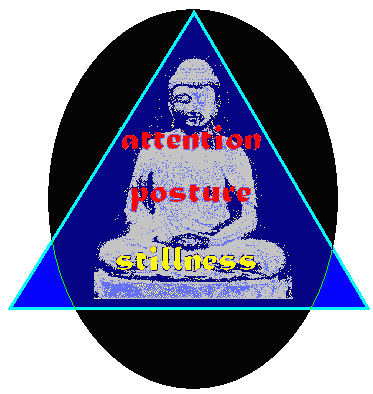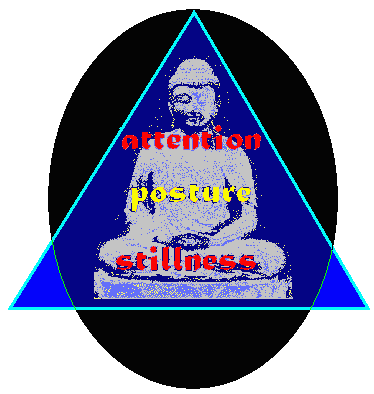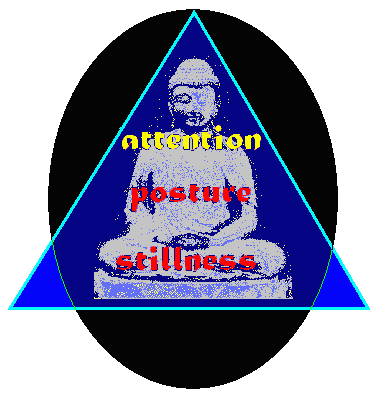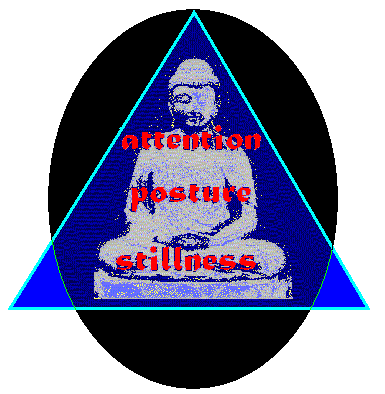Sitting Meditation
by curt steinmetz
updated, corrected and revised on May 3, 2020
"There is no point in much talk,
But the beginner needs various things."
• Part One:
Don't Make Anything
If you sit down, keep your back straight, and keep still for five minutes - you are meditating. Meditation should be kept as simple as possible. Difficult and elaborate meditation "techniques" just add more activity to the mind - rather than standing back and quietly observing the activity that is already there.
An old Zen saying is "don't make anything". In other words, just look at things as they are - observe reality as it is, rather than "making something". Entering into meditation with any kind of expectation is not true meditation. Of course, we always enter into meditation with some kind of expectation, but with a little patience and committment, you can watch those expectations fall away. What you "see" when those expectations fall away is ... well, you have to see it for yourself - that's the whole point.
back to top

• Part Two:
The Mechanics of Meditation: Stillness, Posture, Attention, Coming Back
Stillness: the foundation of sitting meditation
Sitting meditation is actually very simple. Almost too simple, really. All that is necessary is to be silent and motionless for some period of time, and also to remain awake and alert.
If your body remains still, then your mind will become still. This doesn't happen instantly, but it does happen. When your mind is still this doesn't mean a lack of mental activity. It also doesn't mean some kind of trance state or any other altered state of consciousness. A mind that is still is completely ordinary - it is your everyday mind - just a little less cluttered. Sometimes this is called "not-moving mind".
So the first, and most important, thing in sitting meditation is to make a firm committment to be still for some set period of time. This can be as little as 10 or 15 minutes - but you should try to work your way up to at least 20 mintues. After a little practice, sitting still for 30 minutes or even longer can be accomplished by anyone.
 Posture: keeping the string tight
Posture: keeping the string tight
There is a very ancient analogy about meditation - it is said to have been used by the Buddha when he taught his students how to meditate: During meditation you should be like the string of a musical instrument. If the string is too loose then it will make no sound, but if the string is too tight it breaks.
If you are too relaxed (perhaps daydreaming, or even sleeping) during meditation, then that means that your string is too loose. In order to keep the string tight, metaphorically speaking, you assume an upright posture so that the spine is straight, and the upper body supports itself (as opposed to leaning back in a chair, for instance).
The ideal posture for sitting meditation is to sit on the ground - or on a meditation mat and cushion placed on the ground. That way you have a very low center of gravity, and you are very stable. But not everyone is flexible enough to assume this position - so for such people sitting in a chair is fine. You can certainly attain perfect and complete enlightenment sitting in a chair. However, when sitting in a chair it is important to remember not to lean back - the upper body should still be self supported.
However you arrange yourself (in a chair, on a cushion, whatever) you should sit with your pelvis tilted slightly forward (so that the stomache is pushed forward slightly and the butt is pushed backward). The lower back should be arched a little (not a lot). This is what you do naturally when your mother says "sit up straight". With your pelvis tilted forward slightly, and your lower back arched a little, your upper back can easily and naturally be supported in an upright position. It is also important to keep your shoulders back and your head upright. Your eyes should be open, but cast down at a spot about 1 or two feet in front of you - do this without lowering your head, because if you lower your head then the upper part of your spine (ie, your neck) will not be straight. To see people sitting in correct meditation posture check out these handy videos:- Britt Buntain who does a very good job of demonstrating my favorite meditation posture (Burmese)
- Beth Sternlieb, who also demonstrates the Burmese posture, which I think is very good for many beginners (and also many old-timers like myself).
Your hands should be held in front of you in what is called the mahamudra gesture. This is accomplished by placing the left hand on top of the right, so that the middle knuckle of of the middle finger of your left hand rests on top of the middle knuckle of the middle finger of your right hand. The thumbs are brought together so that they touch lightly - when you do this the thumbs and forefingers form an oval. The oval should be centered about 1 inch below the navel. These two websites show correct meditation posture and also illustrate the mahamudra:
 Attention: keeping the body and mind connected
Attention: keeping the body and mind connected
If you sit still and upright then slowly your mind will become very clear. This happens all by itself - it is not really something that you "do". But if you try this you will find that over and over again the mind will wander. You will visit the past and the future - other cities, other countries, even other planets. This is perfectly natural, and it can be quite entertaining and/or interesting, but it is not really what we are after. It would be nice if there were some way to help keep the mind more grounded.
A wide variety of meditation techniques can be used to gently bring the mind back - over and over and over again - as we meditate on our cushions (or our chairs, or seiza benches, or whatever....) These techniques often involve some simple repetitive activity. Very often, but not always, this repetitive activity is linked to the breath.
It is a good idea to keep in mind that the point of meditation is not to become an expert meditator. The point of meditation is to study the mind. To the extent that some meditation technique is useful in the study of the mind, fine. But to simply perform any kind of meditation technique just for its own sake - just as some kind of ritual - only leads to a zombie-like, "stupefied" state.
Two common techniques are breath awareness and mantra.
Breath Awareness: The simplest form of breath awareness, as a meditation technique, is to just focus the mind on the breath. That's it. Just follow the breathing process with your attention. You can make this a little more concrete by adding some kind of (silent) verbal action - like saying (silently, to yourself) "out" every time you breath out.
A slightly different (and very popular) technique is to count the breaths. Starting at "1" count each breath on the exhalation, until you reach "10". After "10" start over again at "1". Any time that you don't know which breath the next one is, or you go past "10", you simply start over again at "1".
Mantra: A mantra is usually some short phrase, or string of sounds, that is repeated over and over and over again in the mind. Sometimes the mantra is in Sanskrit, or Korean or some other language - but sometimes it is just sounds that may not have any meaning in any language. Also, sometimes the mantra is done very very very fast. Then your mind is like a washing machine - the mantra spins around very fast, but in the middle there is something that is very still - and the mind becomes nice and clean. Or the mantra can be repeated silently in time with the breath - a certain number of repetitions on the out breath, and possibly a different mantra, or a different number of repetitions on the inbreath.
 Coming Back
Coming Back
Over and over again the mind wanders off during meditation. If you think you can stop this - go ahead and try. Sometime after the mind has wandered off - eventually you will realize that this has happened. You will remember "hey, I'm supposed to be meditating." At that point you "come back". You straighten your spine, if it is slouched. You open your eyes, if they have closed. You correct your mudra, if the thumbs are not touching lightly and if the thumbs and forefingers are not forming a nice round oval. And you restart counting your breaths - at "1".
And then it happens again. And you "come back" again. And again. And again. And again.
It is important to not make any evaluation of how you are doing during meditation. Don't judge yourself when the mind wanders - just come back. Don't praise yourself when your mind doesn't wander - because, guess what? In the very act of thinking "hey, I'm getting the hang of this" - you have wandered off - so just come back. Just keep coming back.
back to top
• Part Three:
What Happens During Meditation?
Several Different Ways of Describing the Same Thing
A Menagerie of Meditation Metaphors and Images
(1) Tracing Back the Radiance
The habitual tendency of the human mind is to look for truth "outside". There is an old Zen saying: "human beings are perverted - they lose themselves and they chase after things." We tend to not believe in ourselves, so we are always looking outside of ourselves for the Truth. Also we have developed the habit of following thoughts, feelings, sensations, and impulses as soon as they arise in our consciousness. The slightest breeze in our consciousness blows our mind around and around like a leaf.
It is often said that "the purpose of meditation" (a dubious phrase, granted) is not to stop thoughts from arising, but rather to see them at the very moment that they arise. If we buy into this idea, then we can take it a little further still. To see thoughts as they arise means that we have shifted our focus from "outward" to "inward". We are looking back, metaphorically speaking, to where the thoughts are coming from, rather than being carried along by them to wherever it is they are going. Casting our gaze back to the very source of thought is called "Tracing Back the Radiance".
Here is an excerpt by Chinul on Tracing Back the Radiance
(2) The Gap
When meditation is done very meticulously you can actually observe thoughts one by one as they first appear in your consciousness. Maybe. Don't take my word for it.
At any rate, if thoughts can be observed one at a time, it is also possible to observe "the gap" in between thoughts. If you peer into "the gap" you will find that there is nothing there. Nothing whatsoever. There is no bridge from one thought-moment to the next. In other words, there is nothing, in reality, to support the seamless continuity of the self from one moment to the next. Each moment is separate - so the idea that our actions in one moment are somehow constrained by everything that has come before is just that - an idea - not real.
Perhaps, however, it is more realistic to speak of "the gap" in terms of breath awareness. If you are interested in being realistic. If you focus the consciousness on the out breath - then what does the consciousness do in the time between out breaths? Suppose you don't tell your consciousness what to do during that period - except just wait for the next out breath. Then there is a "gap" - a sense of openness or opening. Or Spaciousness. Or Emptiness. Or Whatever. Maybe you can keep your mind completely open during that gap - so that what comes next is truly "the present" - not just a response to the past.
Here is an excerpt by Pema Chodron on The Gap
(3) Stopping and Seeing
This is what I like to call the "Meditation as Bird-Watching" approach to meditation. In order to be a good bird-watcher, the main thing that you have to do is to stop doing everything that is not bird-watching. You don't really have to go looking for birds - they are everywhere. As soon as you stop doing everything that is not bird-watching, you see all of the birds that were there already.
Of course people often want to watch specific kinds of birds - especially rare birds (as opposed to the starlings and robins and pidgeons and crows that you can always see almost anywhere). To do that you might have to first travel to a good place to find the particular kinds of birds you are interested in - but once you have accomplished that, the same principle holds - you have to stop everything else, and just observe.
Here is an excerpt by Master Tien T'ai on Stopping and Seeing
(4) Sitting Quietly, Doing Nothing
This is really is not a description of meditation, so much as it is a refusal to even try to describe that which is beyond description - but in a light-hearted way. A more serious, perhaps even heavy handed, way of saying "sitting quietly, doing nothing", is to use the Japanese term "shikantaza". It is more or less the same as what Tibetan Buddhism calls "Mahamudra" or "Dzogchen".
The idea here is what is often called "formless meditation". It is not really "formless" - rather it would be more accurate to say that it is not limited to, or tied to, or dependent on any particular form. In other words, "doing nothing" doesn't really mean "doing nothing" - rather it means that from moment to moment our activity is just to respond naturally and directly to the very moment itself.
Here is an excerpt by Alan Watts on Sitting Quietly, Doing Nothing
(5) Listening
Listening is a lot like bird-watching. In order to listen you must stop doing everything that is not listening. But if you look into it, there are subtle differences between the metaphor of "Listening" and that of "Stopping and Seeing". First of all, one does not "stop and listen" - one simply "listens". Also, listening is inherently panoramic - taking in everything around us, instead of being focused in one particular direction.
The Bodhisattva Avalokitesvara came to complete realization though the practice of Listening. Avalokitesvara (Kwan Yin, Kannon, Kwan Seum Bosal) listens to the cries of all the suffering beings in the universe. This is the very heart of Compassion. We often think that compassion necessarily means to "do something" to help someone who is suffering - but all too often the desire to "do something" about suffering only leads to more suffering. In a universe that is completely filled with suffering, the most important thing is to simply not turn away. To listen. To open ourselves completely to suffering. True compassionate action can only come from that kind of opening.
Here is an excerpt by my teacher, Zen Master Dae Gak, on Listening
(6) Naked Ordinary Mind
Shunryu Suzuki Roshi once said "Studying Buddhism doesn't really mean studying Buddhism. Studying Buddhism means studying the mind." But what kind of mind do we study? Often people think of meditation as a way of manipulating the mind to get it to do certain things. Maybe we want the mind to relax, or maybe we want to be completely focused on just one thing, or maybe we want to induce altered states of consciousness. None of that is true meditation. True meditation means seeing the mind just as it is.
When you go to the doctor the doctor must see you just as you are - just the ordinary "you". It would be a big mistake to try to present something other than the ordinary you to your doctor. Also, the doctor must see you naked - in order to see your body as it is. Often the doctor can't even stop there - and must look even underneath the skin. In order to study the mind, we have to become like doctors - and, more importantly, our mind should be like a good patient - naked and ordinary.
Here is an excerpt from Jamgon Kongtrul on Naked Ordinary Mind.
(7) The Cow With No Nostrils
A cow is a very big animal - and it is not very easy to control. But a cow has very sensitive skin in between its nostrils - if you pierce this skin and put a ring through, then the cow becomes easy to control. If you tug on the ring in a cow's nose it will go wherever you lead it.
We are all like the cow with a ring in its nose. We are all very easily led around - because of the very sensitive skin in between our nostrils (metaphorically speaking). But if you become a "cow with no nostrils" then you are completely free.
The Cow With No Nostrils figures very prominently in the Story of Kyong Ho as told here by Zen Master Seung Sahn.
back to top
• Part Four:
Getting Started
Someone once asked: "What does 'sitting correctly and contemplating true reality' mean?" The master replied: "A coin that is lost in the river is found in the river." (from "The Record of Yun Men")
Here is some very basic advice for anyone who wants to begin meditating.
Make a firm committment to practice every day, starting at 10 or 15 minutes a day. Sit still in whatever posture you can manage - remember that sitting in a chair is OK. While sitting be sure to keep your back straight, your hands in the mahamudra, and your eyes open. And use "breath counting" to keep your mind alert and focussed on your meditation. Don't worry about how many times you have to "come back" - just keep coming back.
When you meditate it is inevitable that all kinds of thoughts and emotions and other stuff will arise in your consciousness. Shunryu Suzuki Roshi used to say that when these "visitors" arrive at the door of your mind, its OK to let them in - just don't offer them tea! Trying to block out thoughts, emotions, etc, will only lead to frustration. Instead, just keep your attention focussed on your posture and your breathing. And whenever you wander off - just come back. Everytime you straighten your back, or correct your mudra, or open you eyes, or start over again at "1" - it should be viewed as another opportunity to observe the activity of your own mind.
After a week of practicing every day for 10 or 15 minutes, increase the time by 5 minutes. Then the next week increase by another 5 minutes, etc - until you are up to at least 25 minutes, preferably 30. Going up to 40 minutes is a good idea if you can manage it - also its a good idea to try to practice twice a day, once early in the morning, and once in the evening. But even just sitting once a day for 15 minutes is infinitely better than not practicing at all.
Also you should try to find a meditation group to practice with at least once a week. Trust your instincts and find a group that you feel comfortable with.
Finally, if you want to read something "about Zen" (Zen teachers always tell students that reading about Zen is no good - but all the while they are working on their next book!) , I would recommend four of my personal favorites:
There are lots of good books on Zen - and even more lousy ones, but these four books all follow Albert Einstein's sage advice to "make everything as simple as possible - but no simpler."
back to top
• Part Five:
Put It All Down
A princess once came to ask the Buddha for meditation instruction. She had brought with her fine sandalwood incense and rare jewels and other stuff that she thought would make an appropriate offering to such a famous teacher. She wanted to present all of this to the Buddha personally, so instead of having one of her servants carry it (which is what she normally would have done) she carried all of it herself.
When she came to the Buddha she had both arms full of these expensive and exotic goodies. The Buddha looked up at her and asked her why she had come. She said that she wanted the Buddha to teach her how to meditate. The Buddha then said simply "Put it down." So she put down one arm-load of her offerings - right at the Buddha's feet. Then the Buddha said again, "Put it down." So she put down the rest of her offerings at the Buddha's feet. Then the Buddha said "Put it all down."
There was a famous Korean Zen Master named Seung Sahn (he was my teacher's teacher) - he was very fond of this teaching phrase "put it all down." He said it all the time. Sometimes it seemed like it was all he ever said! One time a student asked Zen Master Seung Sahn, "But HOW do I 'put it all down'?" Zen Master Seung Sahn replied, "Put THAT down, too."
back to top
• Links to Other Online Meditation Instructions
(all of these links are working as of April 27, 2020)
And be sure to check out the "meditation supplies" links on our Zen Links page.
back to top

 Posture: keeping the string tight
Posture: keeping the string tight Attention: keeping the body and mind connected
Attention: keeping the body and mind connected Coming Back
Coming Back